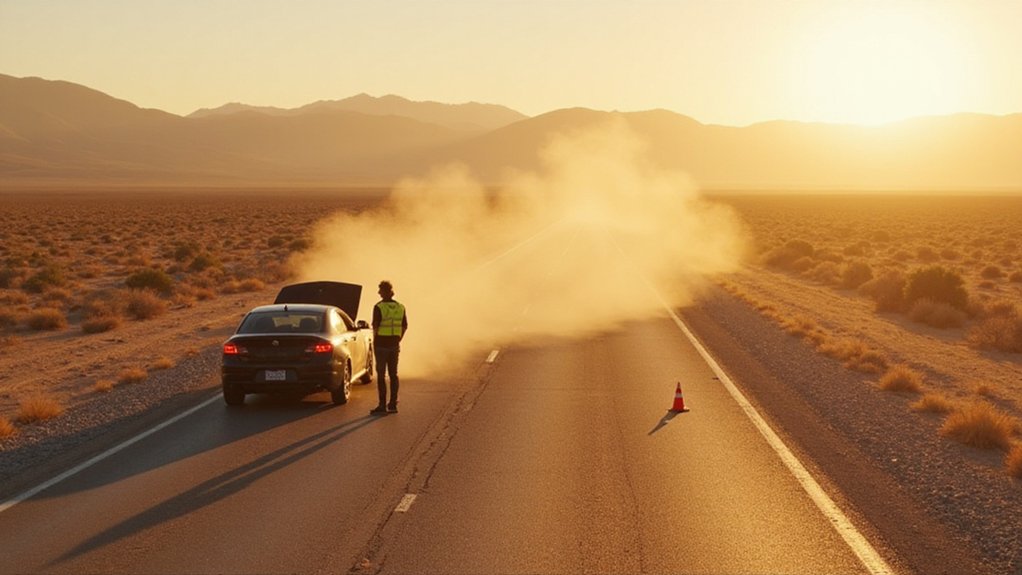If your car breaks down, stay calm and prioritize safety. Immediately turn on hazard lights and pull over to the shoulder. Keep doors locked and stay inside if you're in a high-traffic area. Check for warning signs like unusual sounds or dashboard lights. Call roadside assistance, providing your precise location. Have an emergency kit ready with essentials like a charged phone, spare tire, and contact information. Your next steps could make all the difference.
Ensure Your Safety
When your car breaks down, your top priority should be protecting yourself from potential roadside dangers. Slowly pull your vehicle to the safest area possible, preferably onto the shoulder or a wide emergency lane, away from traffic.
If you can't move your car, turn on your hazard lights immediately to alert other drivers. Stay inside your vehicle with doors locked if you're in a high-traffic or unfamiliar area.
Keep a warning triangle or reflective vest in your trunk to increase your visibility and help other drivers see you more clearly. If you need immediate assistance, consider calling roadside assistance professionals who can help you quickly and safely.
Alert Other Drivers
After ensuring your safety, the next critical step is making your presence known to other drivers. Turn on your hazard lights immediately to signal that you're experiencing an emergency.
If it's nighttime or visibility is low, place reflective triangles or flares behind your vehicle to warn approaching traffic. You'll want to position these safety markers about 50 feet from your car to give drivers ample time to see and react.
If you're in Northeast Ohio coverage, consider calling a local 24/7 emergency towing service for immediate assistance.
Diagnose the Problem
If your car's performance suddenly seems off, it's crucial to quickly assess what might be causing the problem. Check for warning lights, unusual sounds, and strange vibrations that could indicate underlying issues.
| Symptom | Possible Cause | Recommended Action |
|---|---|---|
| Engine Light | Sensor Problem | Check Manual |
| Smoke | Overheating | Stop Safely |
| Grinding Noise | Brake Issue | Reduce Speed |
| Steering Difficulty | Power Steering | Pull Over |
| Dashboard Warnings | Electrical Problem | Call Mechanic |
Understanding your vehicle's signals can help you make informed decisions and prevent more serious damage. Don't panic; stay calm and methodically evaluate the situation.
Call for Assistance
Three key steps can help you effectively call for roadside assistance when your car breaks down.
First, stay calm and locate your emergency contact information, whether it's through your car insurance, a roadside assistance membership, or a trusted towing service.
Next, provide your precise location by using mile markers, road signs, or GPS coordinates to help responders find you quickly. Be ready to describe your vehicle's condition, any visible issues, and whether you're in a safe area.
Communicate clearly and remain patient while help is on the way.
Prepare for Roadside Emergencies
Being prepared can make a significant difference when unexpected car troubles arise. You'll want to assemble a roadside emergency kit that includes essential items like jumper cables, a flashlight, basic tools, water, non-perishable snacks, and a first-aid kit.
Keep a spare tire, jack, and tire iron in good condition, and make sure they're easily accessible. It's also smart to have your cell phone charged and a portable battery charger on hand.
Familiarize yourself with your car's manual and know how to change a tire or jump-start your battery. These simple preparations can help you stay calm and safe during a breakdown.
Frequently Asked Questions
How Long Can I Safely Stay Inside My Car During a Breakdown?
You'll want to stay in your car if it's safer than outside, but limit your time to prevent carbon monoxide buildup. Keep windows slightly open and run the engine periodically for short intervals.
What if My Phone Battery Is Dead When My Car Breaks Down?
If your phone dies, don't panic. Ask passing drivers for help, look for roadside emergency phones, or flag down a highway patrol vehicle. Stay visible, stay safe, and trust someone will assist you.
Are There Legal Requirements for Roadside Emergency Equipment in My Vehicle?
You'll want to check your state's specific laws, but most require a reflective triangle, spare tire, jack, jumper cables, and flashlight. Having these can help you stay safe and legally compliant during roadside emergencies.
Can I Get Compensation From My Insurance for a Roadside Breakdown?
You'll likely get roadside assistance coverage if it's part of your policy. Check your insurance details, and you might receive towing, battery jump-start, or fuel delivery compensation without extra charges.
How Do I Know if It's Safer to Stay or Leave My Vehicle?
If you're in a dangerous area, leave your vehicle quickly. But if it's a safe spot, stay inside with doors locked, hazards on, and wait for help or roadside assistance.



